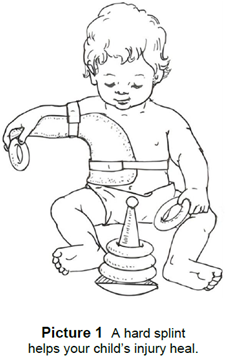Hard Splints


Your child needs to wear a hard splint (Picture 1). A hand therapist will fit your child with a custom splint. Hand therapists fit splints for the upper and lower body, even if the hands aren’t splinted. The splint will:
- Stop the arm or leg from moving.
- Keep the limb in the best position for it to heal.
- Keep a muscle stretched and prevent it from tightening or shortening after an injury. This is called a contracture. To prevent contractures, your child must wear the splint as instructed by their doctor or health care provider.
When Your Child First Gets a Splint
- When the splint is first put on, your child may feel pain. This happens when a tight muscle is stretched. After 15 minutes, the muscles in the limb will relax, and the pain should go away. Let your child’s hand therapist or health care provider know if they have pain after 30 minutes.
- After 30 minutes, check for swelling or a change in the color of the skin. Compare the limb that has the splint with the one that doesn’t.
- When you take the splint off, your child’s skin may have small, red marks and indents where the edges of the splint pressed into the skin. If these don’t go away after 30 minutes, the fit of the splint may need to be adjusted.
Care of the Splint
- The splint can melt. Keep it away from heat sources, like direct sunlight, hot water, near a heater, or in a hot car.
- Clean the splint with rubbing alcohol or soap and cool water. Dry it well.
- If the splint has Velcro® straps:
- Check them for lint. Too much lint will keep the straps from sticking to the Velcro. Pull the lint out of the Velcro with your fingers.
- Hand-wash the straps with mild soap and water.
- If the straps wear out, call your child’s hand therapist to make an appointment for new straps. The fit of the splint will also be checked.
- If a bandage, like Kerlix® or Conform®, holds the splint on, change the wraps when they get dirty. At first, the hospital will give these to you.
Follow-up Appointments
- Please bring the splint to all clinic and office visits.
- A hand or occupational therapist in the orthopedic outpatient clinic will readjust the fit of the splint as needed.
- Your child’s doctor and hand therapist will tell you when they can stop using the splint.
HH-II-3 • ©1986, revised 2023 • Nationwide Children's Hospital
